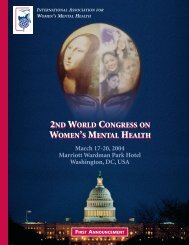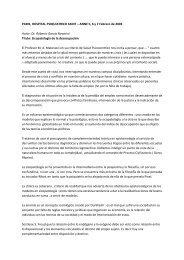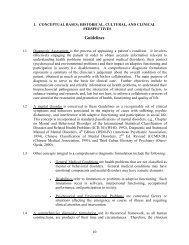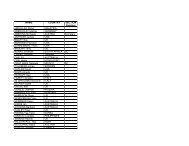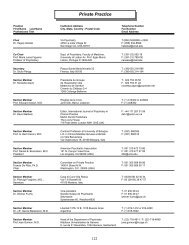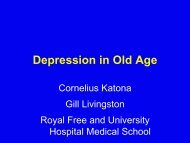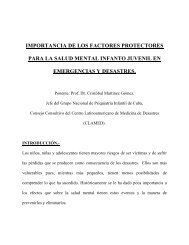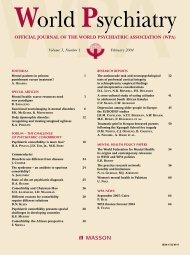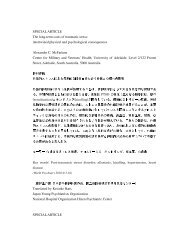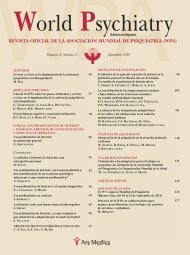ABSTRACTS - World Psychiatric Association
ABSTRACTS - World Psychiatric Association
ABSTRACTS - World Psychiatric Association
You also want an ePaper? Increase the reach of your titles
YUMPU automatically turns print PDFs into web optimized ePapers that Google loves.
ESI SM TOP-CITED SCIENTIST LECTURES<br />
TL1.<br />
THE TREATMENT GAP IN PSYCHIATRY<br />
R.C. Kessler<br />
Department of Health Care Policy, Harvard Medical School,<br />
Boston, MA, USA<br />
Data are presented on patterns, self-reported reasons for, and sociodemographic<br />
correlates of unmet need for treatment of mental disorders<br />
in 23 countries around the world. The data come from general<br />
population surveys carried out as part of the <strong>World</strong> Health Organization’s<br />
<strong>World</strong> Mental Health (WMH) Survey Initiative. Results show<br />
that a high proportion of people with DSM-IV mental disorders in all<br />
countries’ surveys fail to receive any form of professional treatment<br />
for their mental disorders. The data also show that many patients<br />
receive treatments that fail to meet even the most minimal acceptable<br />
standards of treatment quality. Unmet need for treatment is lower for<br />
more severely impairing than less severe cases, but is quite high even<br />
in more severe cases. Reason analysis shows that lack of perceived<br />
need, predisposing factors, and enabling factors all play separate roles<br />
in accounting for this treatment gap. Important insights into the<br />
causal processes that lead to associations between socio-demographic<br />
sources of health care disparities and unmet need for treatment<br />
emerge by including these factors in the reason analysis.<br />
TL2.<br />
PSYCHIATRIC GENETICS: A CURRENT<br />
PERSPECTIVE<br />
K. Kendler<br />
Virginia Institute of <strong>Psychiatric</strong> and Behavioral Genetics,<br />
Medical College of Virginia/Virginia Commonwealth University,<br />
Richmond, VA, USA<br />
This paper will first review the four major paradigms currently active<br />
in psychiatric genetics: simple genetic epidemiology, advanced genetic<br />
epidemiology, gene-finding methods and molecular genetics. It will<br />
then review selectively advances in each of these areas, trying to illustrate<br />
the methodological strengths and limitations of each approach.<br />
In the area of advanced genetic epidemiology, we will review examples<br />
of genetic models of development, sex-modification of genetic<br />
effects, gene by environment interaction, and gene by environmental<br />
correlation. In the section on gene finding methods, we will review<br />
candidate gene association and linkage but focus on gene-wide association<br />
methods. We will provide an up to the minute assessment of<br />
progress in this very rapidly moving area. We will also briefly touch on<br />
genomic approaches, especially copy number variants and the challenges<br />
posed by allelic heterogeneity and the rare variant common<br />
disease model for psychiatric disorders.<br />
TL3.<br />
BIPOLARITY: A BROAD SPECTRUM (SPECTRA)<br />
IN SEARCH OF TREATMENT<br />
H.S. Akiskal<br />
University of California at San Diego, La Jolla, CA, USA<br />
“Bipolar spectrum” first appeared in the psychiatric literature in a<br />
1977 paper on a prospective follow-up of cyclothymic individuals:<br />
most developed depression or bipolar II, fewer developed full blown<br />
manic-depressive illness and, significantly, nearly half the sample<br />
treated with antidepressants developed increased cycling. Much of<br />
the evidence for this broadened bipolar concept has come during the<br />
past few years. Subthreshold bipolar conditions have been identified<br />
in the community and several epidemiological studies, in both<br />
Europe and the United States, showing an average population prevalence<br />
of 5%. Prospective follow-up has shown progression of subthreshold<br />
bipolarity to full-blown bipolar disorders. There has been<br />
great momentum in the clinical literature to study the various forms of<br />
the bipolar spectrum, which, in addition to the well-known types I<br />
and II in the DSM-IV and ICD-10 terminology, include depressions<br />
with shorter hypomanias, hypomanias elicited by antidepressant<br />
treatment, depressions arising from various bipolar temperaments<br />
such as the cyclothymic and the hyperthymic, as well as depressions<br />
with intra-episode hypomania (depressive mixed state). Despite criticism<br />
from some quarters, bipolar validation has been achieved for<br />
most of these forms in rigorously conducted studies coming from various<br />
clinics in the world, particularly the United States, Italy, Germany,<br />
Switzerland and Hungary, as well as two national studies from<br />
Poland and France. Other proposed bipolar concepts refer to issues<br />
that have to do with “unipolar” depressions with high recurrence,<br />
atypical depression, seasonality, early age at onset, depressive and<br />
dysthymic states with bipolar family history, and affective states<br />
occurring in the setting of multiple anxiety disorders, as well as those<br />
in the post-partum period. In addition, controversial proposals have<br />
been made to hypothesize that borderline personality disorder, dissociate<br />
states, polysubstance abuse, particularly cocaine and stimulant<br />
abuse, might be related to the bipolar spectrum. Other “candidates”<br />
for the bipolar spectrum include affective comorbidity with migraine,<br />
eating disorders, gambling and a variety of impulse-control disorders.<br />
This is a large terrain and beyond the conventional literature, but of<br />
major significance for public health, clinical psychiatry, psychiatric<br />
theory and research methodology, including genetics. Thus, the field<br />
has progressed to the point of proposing some “soft” bipolar conditions<br />
as behavioral endophenotypes for bipolar disorder, for which<br />
genetic loci have been proposed in preliminary studies. While uncritical<br />
acceptance of such a broad spectrum (or spectra) is not justified,<br />
criticisms of the bipolar spectrum without adequate familiarity of the<br />
entire literature are equally unwarranted. Much of what has driven<br />
treatment in practice has involved applying what works for the hard<br />
spectrum to the soft spectrum and beyond. Such therapeutic application,<br />
currently largely the domain of clinical judgment, should move<br />
to rigorous therapeutic trials in the service of public health, as it is<br />
happening in such fields as diabetes and hypertension. Primary and<br />
secondary prevention, including that of suicidal behavior, is an eloquent<br />
driving force to address the spectrum of therapeutic challenges<br />
in psychiatry in this broad domain – challenges which are no less in<br />
magnitude than those in medicine at large.<br />
TL4.<br />
PHARMACOTHERAPY OF BINGE EATING<br />
DISORDER<br />
S.L. McElroy<br />
Lindner Center of HOPE, Mason, OH; University of Cincinnati<br />
College of Medicine, Cincinnati, OH, USA<br />
Binge eating disorder (BED) is the most common eating disorder.<br />
Patients with BED engage in frequent, recurrent episodes of binge<br />
eating without the compensatory weight-loss behaviors of bulimia<br />
nervosa or anorexia nervosa. Many of these patients suffer from mood<br />
symptoms or disorders and/or obesity. A growing number of pharma-<br />
1



